Samambaia is a magnificent Phinisi, a traditional Indonesian wooden sailing vessel, built and designed offer her guests only the top world's rated dive sites of Indonesia with absolute comfort, safety, and autonomy regardless the remoteness of the dive point.
The beautiful MV Samambaia has a super-spacious top sun deck which can be covered, uncovered or partially covered, as you wish. Grab your lounge chair and relax ! Moving down one level, the main deck features an extremely attractive & generously sized, air-conditioned salon and dining room. The lovely master cabin is located on the aft deck and features a spectacular 180° view through large picture windows with a special coating which ensures privacy. Also on the main deck is the galley and, creatively placed, using space ingeniously, is a large outdoor dining area at the center of the spacious dive deck. The remaining 6 cabins are located on the lower deck.
The chef will spoil you with delicacies from an international menu, while focusing on fresh local ingredients. Fresh bread and pastry are prepared every day. Fish and seafood are carefully chosen from sustainable sources only.
You'll be impressed by the attention to detail on the boat. Spa treatments are available, you'll have free WiFi on the occasions you can catch a signal ... and land visits & snorkeling are possible on many of the itineraries.
Master Stateroom (1 room)
Situated on the main deck she affords a 180 degree view through the large picture windows with a special coating that ensures privacy. Enjoy the comfort of a large king size bed and individually controlled air conditioning.
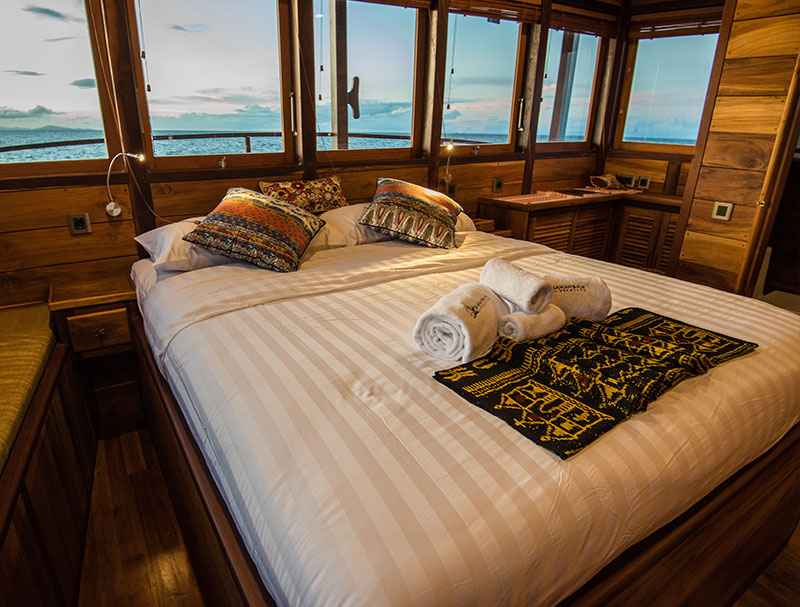
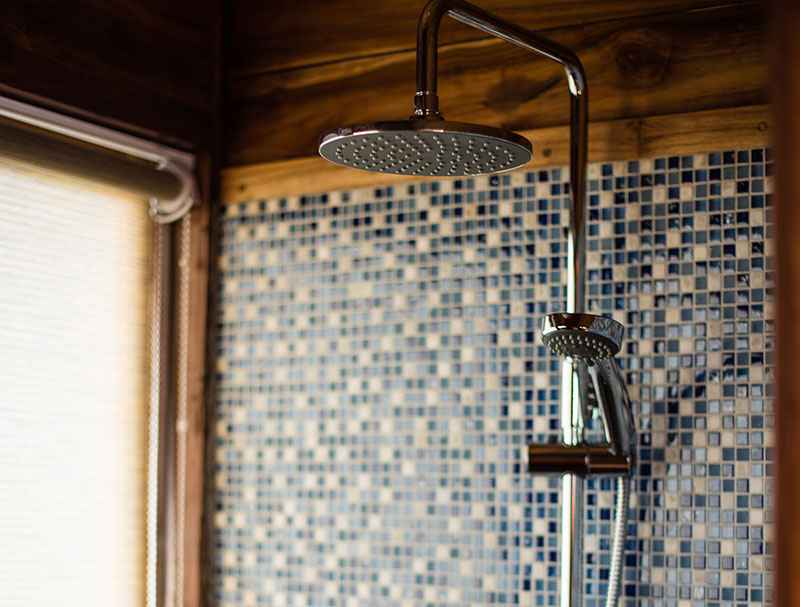
Double Staterooms (4 rooms)
Fitted with a king size bed, private bathroom, porthole windows as well as individually controlled air conditioning.
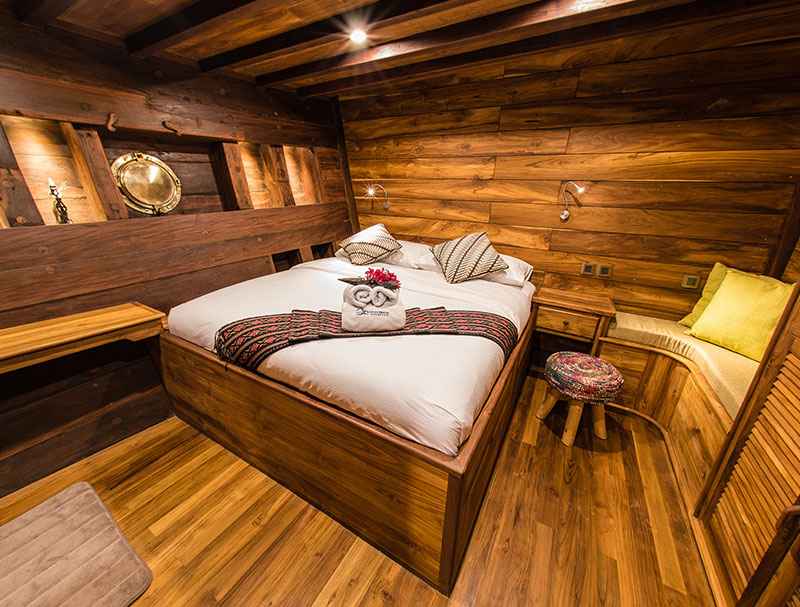
Twin Staterooms (2 rooms)
Two large twin beds (side-by-side), private bathroom, porthole windows as well as individually controlled air conditioning.
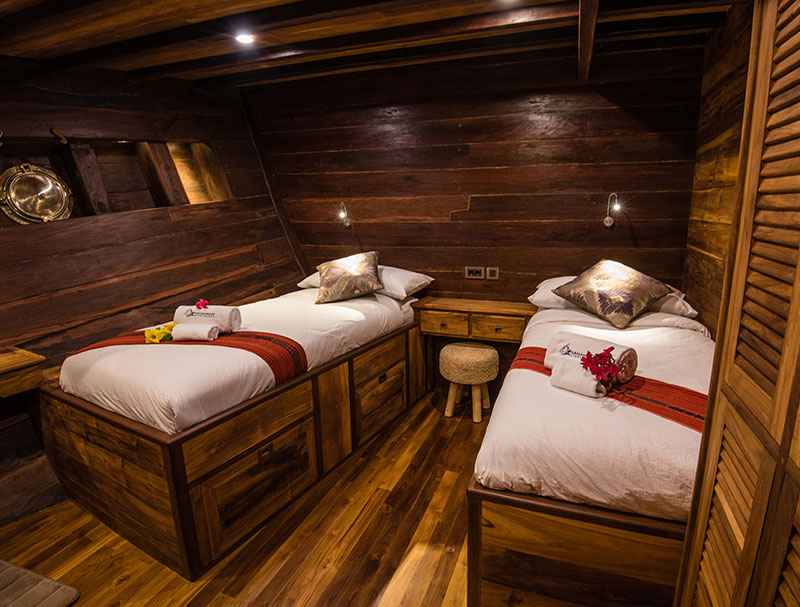
Embark on an unforgettable journey to four of the world’s premier diving destinations: Raja Ampat, Triton Bay, Banda Sea, Alor, and Komodo. Each location offers a unique underwater experience, from vibrant coral reefs to encounters with majestic marine life. Whether you're exploring the biodiversity of Raja Ampat or the dramatic landscapes of Komodo, these destinations promise an adventure of a lifetime beneath the waves.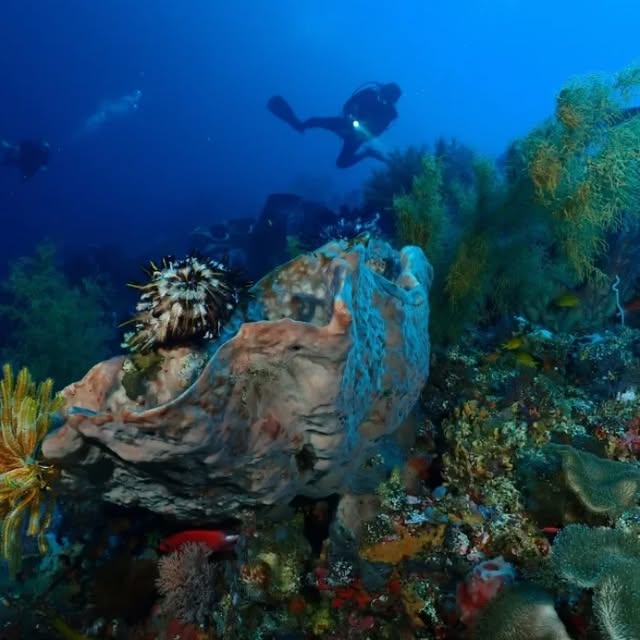
Komodo National Park (Jul-Aug)
Established in 1980, Komodo National Park was designated a Biosphere Reserve under the UNESCO Man & Biosphere Program and became a World Heritage Site in 1991 and offers stunning dive opportunities. The Komodo National Park is composed by the two larger islands - Komodo and Rinca; and about 80 smaller islets. The park hosts one of the richest marine environments including coral reefs, mangroves, seagrass beds, seamounts and semi-enclosed bays where has been registered more than 1,000 species of fish, 260 species of reef-building coral and 70 species of sponges. Sea turtles and marine mammals live in the waters of Komodo, and passing whales are also spotted. If Komodo's underwater delights were not enough, there is also the 3 meters long lizard walking around Rinca, Nusa Kode and Komodo and looking like something coming straight from the age of the dinosaurs. For many divers Komodo offers the best diving in Indonesia and right up there with the leading dive destinations in the world. Komodo boast stunning scenery both above and below water due to its unique volcanic geology. The Komodo archipelago is a dramatic hilly landscape of wild savannah and some patches of forest; blue lagoons; and white, pink and red sandy beaches that host some of the most spectacular underwater scenery in the world. Komodo has a reputation for being a diving area for experienced divers. This is true, especially if you want to visit on Komodo by liveaboard. Komodo has many dive sites with strong and sometimes unpredictable currents. Water temperatures change often and are sometimes far below the usual 28°C you will find in other parts of the Indonesian archipelago. In the southern area of Komodo National Park water temperatures may be as low as 21°C. We advise a 5-mm wetsuit before diving Komodo to avoid any cold dives! The Southern waters generally provide better visibility from December through April. Lower visibility occurs in the South during the dry season when oceanic up-welling and plankton blooms, attracts a wealth of marine life to Komodo, especially invertebrates. Highest temperatures in the south are during the rainy season. Komodo's Northern waters generally provide better visibility year round. Fish is abundant everywhere but the rocks and reefs in areas of stronger current provide the best chances of spotting the bigger fish, especially sharks and other pelagic species.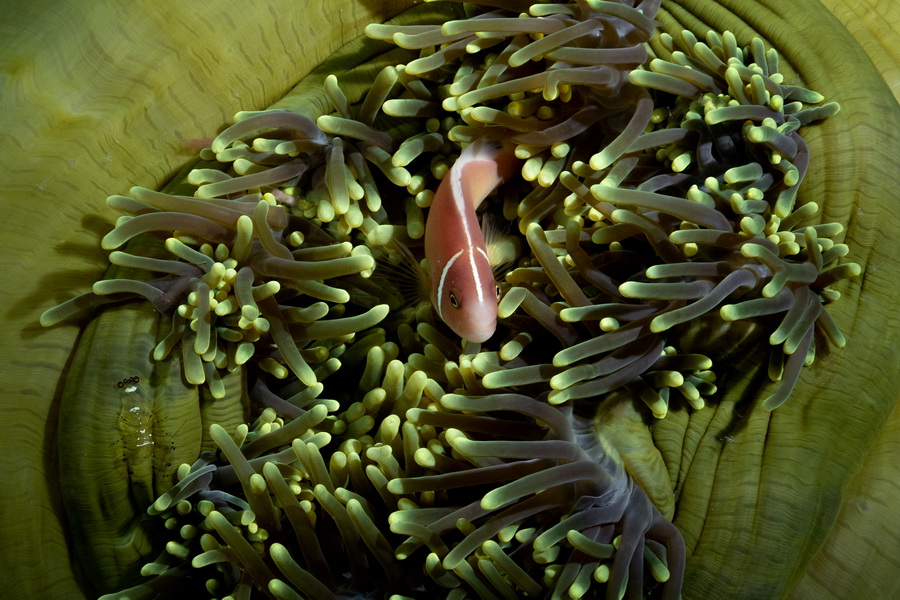
Raja Ampat (Nov-Mar)
Far to the wild eastern edge of the Indonesian archipelago there is a region with thousands of islands offering as many sites for scuba diving right in the heart of the Coral Triangle.
It’s no a surprise that photographers and divers flock here from around the world to spend one or two weeks on a liveaboard diving trip, because is the only way to travel throughout this large geographic area with practically no development.
You can be sure every effort will be rewarded: Raja Ampat homes more than 1400 species of fish and almost 600 different corals - 75 percent of all known coral species -, you’ll have the chance to see more marine life in Raja Ampat than anywhere else on the planet, whatever it is: fish, coral, mollusks or invertebrates; Raja Ampat is certainly one of the best scuba diving destinations in the world.
Raja Ampat, literally "Four Kings", is conformed by four main islands Waigeo, Batanta, Salawati and Misool and more than thousand sand and rock small islands, with the most different underwater morphologies: slops, ridges, channels, caves, tunnels; and an astounding diversity of habitats, each one with a different kind of diving experience: sandy bottoms as life-size aquarium, blue-water mangroves systems hosting pigmy seahorses and saltwater crocodiles at once, ideal calm sand flats as cleaning station for oceanic mantas, perfect murky and silt-ridden conditions for the muck diving lovers, a river-like saltwater channel of strong currents and great walls plentiful of invertebrates, Raja Ampat has everything a diver can want.
Divers generally enter this region via the airport at Sorong on the Indonesian province of West Papua. The first dive sites will often be around the island of Wai, only a two-hour boat run from Sorong, the quality of dives range from good to wonderful. Some dives are planned for slack tide, while occasionally the current can be challenging. Fortunately, the stronger currents also generally made for better visibility, blooming corals and greater fish activity. Best time to dive Raja Ampat is from October to April. Topside conditions at this time of year proved to be excellent. You could enjoy cruising in virtually flat calm seas, with only some rain showers punctuating warm, sunny days.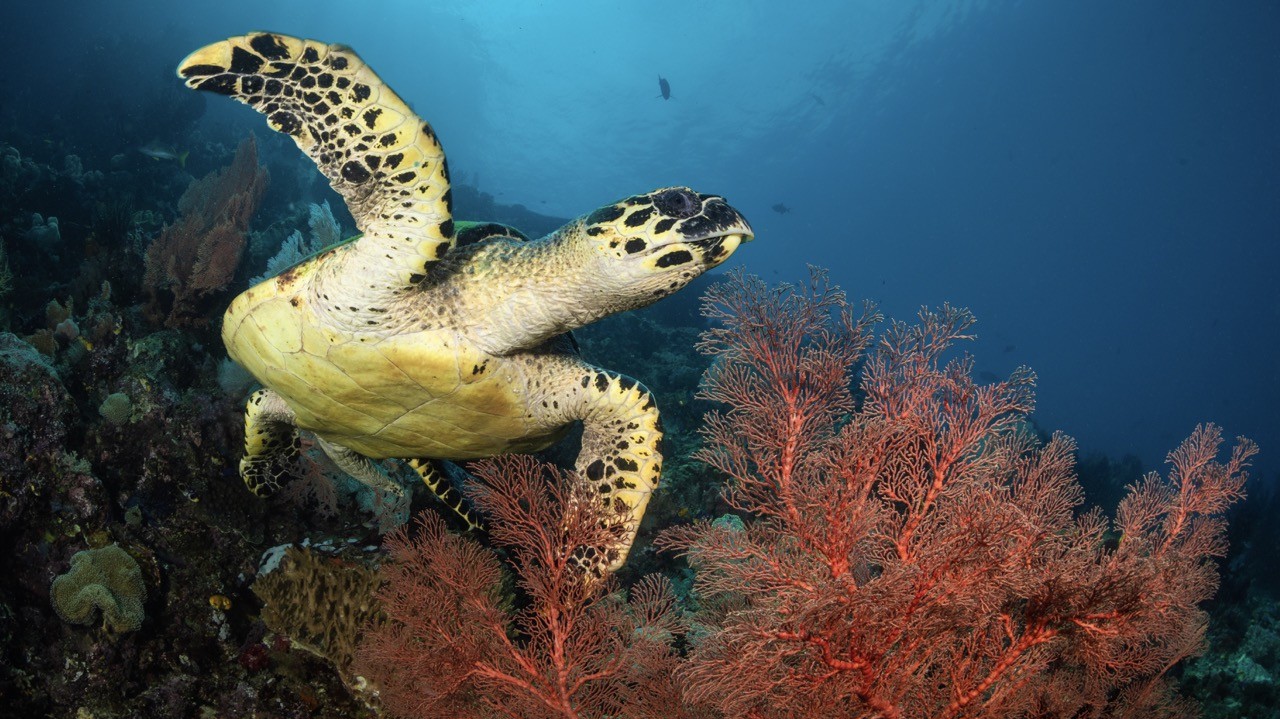
Triton Bay (Oct / Jun)
Many of the once-uncharted scuba destinations have become popular hotspots, but Triton Bay in far eastern Indonesia remains a hidden gem. This vibrant locale is a diver’s paradise, with an extraordinary fish-to-human ratio that favors those with gills. The biodiversity here is astounding, and the colorful reefs pulse with life, waiting to be explored.
Whale sharks frequent Triton Bay, taking advantage of the local fishermen’s nets to snag a breakfast of anchovies. Near Namatota Island, traditional fishing platforms called bagans extend from boats, where fishermen drop nets each night. When they haul in their catch, it’s not uncommon to find one or more massive whale sharks circling below, eagerly feeding. The fishermen often share their bounty, tossing handfuls of anchovies to these gentle giants, creating a unique partnership. Dive operators benefit by paying the fishermen a stipend for the chance to bring divers into this extraordinary experience, while scientists have established tagging programs to study these majestic creatures.
The currents of Iris Strait, which separates Triton Bay from Aiduma Island, serve as a nutrient-rich conveyor belt, supporting a vibrant marine ecosystem. Here, schools of pinjalo snapper dance above colorful reefs at Batu Dramai, often joined by fusiliers, surgeonfish, and other species, creating an exhilarating underwater spectacle. While conditions can vary, those fortunate enough to dive in this area are treated to a stunning array of marine life. The dive sites around Batu Dramai and nearby Christmas Rock are renowned for their biodiversity, attracting only a lucky few divers eager to experience Triton Bay’s vibrant pulse.
For critter enthusiasts, Triton Bay is a “species factory.” The isolation and diverse microhabitats here contribute to a remarkable array of marine life. Divers can encounter unique species like the adorable walking shark and the speedy Nursalim flasher wrasse, perfect for macro photography. This area is a paradise for those seeking to uncover the underwater world’s smallest wonders.
The Kaimana Marine Protected Area, encompassing Triton Bay, Aiduma Island, and numerous smaller islets, offers an endless canvas for underwater photographers. The reefs boast fields of black coral, intricate plate corals, and vibrant soft coral gardens. Unlike the crowded dive spots of Raja Ampat, Triton Bay provides ample space to explore unspoiled reefs, allowing for an intimate connection with nature.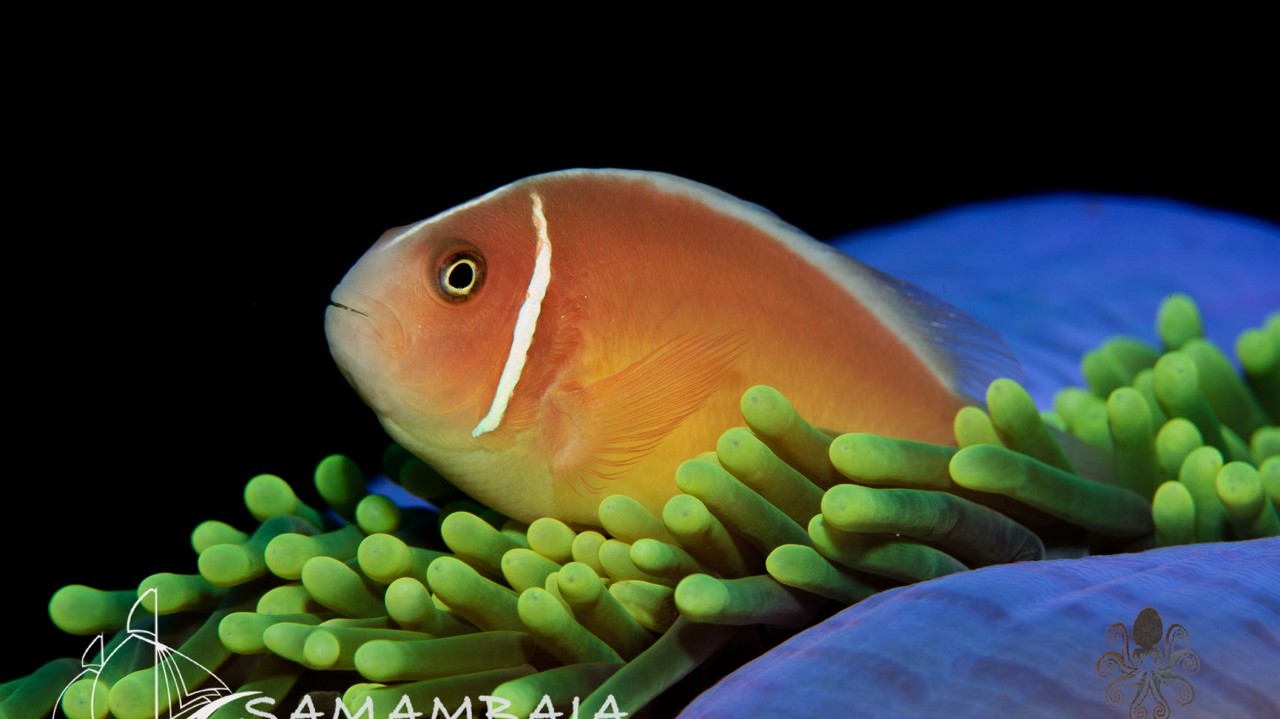
Banda Sea (May-Oct)
This journey cruises through a wide range of geological landscapes and formations of Indonesia, from volcanic islands to limestone pinnacles developed from ancient coral reefs. As we cruise along the natural migratory paths and playgrounds of marine mammals such as whales and dolphins, this trip is guaranteed to provide amazing diversity and beauty both above and below the water. The Banda Sea is blessed with some of the finest diving in the country. Banda Islands Banda had an important place in Indonesian and world history. Dominated by a 2.000 feet active volcano, for more than three hundred years these tiny islands were the centre of wealth for the Dutch colonies. They were the only source of the rare spices of nutmeg and mace for centuries and the Dutch, after capturing them from the Portuguese, guarded them jealously from all comers including the English. For centuries, a kilo of these spices held more value than the same weight in gold. The old fort, the governor's house, the church, nutmeg plantations, are well worth visit and bring us back to colonial era. Let's not forget the diving, both Pulau Run and Pulau Ai have pristine clear waters, lovely walls and good fish life, we might go a bit deeper in search of more hammerheads, big fish can be seen here as well, napoleons, schools of black snappers, bumpheads, etc. The outer reefs of Bandaneira are full of marine fauna of all colors and shapes. Schooling fish gather and the macro life is rich. A really unique area is the dive under the pier of Bandaneira. The size of the mandarin fish are just out of this world and if you are looking for other critters, cockatoo wasp fish, flying gurnards, frog fish, juvenile barramundis, juvenile emperor angle fish, juvenile sweetlips. Of course diving is our main focus and the dive site Lava Flow is not to be missed. Twenty years ago Gunung Api erupted and the lava poured into the ocean and in the short time since a hard coral garden grew which is unrivalled in the world. Table corals are over 5m width, staghorn corals as far as the eye can see and even endemic species found nowhere else is just a sample of what you can see here. Gunung Api It’s a volcano that’s summit breaks the sea’s surface by 800 feet yet which has its base on the seabed some 13.000 feet below. The island created by the volcano is 120 miles from the next nearest landfall and is therefore home to the reef fish that populate its steep drop offs and walls, occasional visiting pelagics, and extraordinarily an uncountable population of banded and olive sea snakes. These marine reptiles have found a sanctuary here among the warm volcanic vents and reef fish that live in the area. It is truly a unique spot that never ceases to amaze divers. In some shots there are over thirty snakes in the frame and they make inquisitive yet docile subjects. Lucipara In the north of Gunung Api is a remote archipelagic atoll named Lucipara. These atolls are also surrounded by a seafloor that is 3.000 feet below and consisting of three large islands and a few tiny reefs that just break the surface. The islands offer vertical walls and visibility of over 120 feet with very mild currents. They are also home to a population of the large sponges. Some barrel sponges can swallow a diver in their orifice without difficulty. Wetar The west coast of Wetar boasts amazing dive sites with drop-offs, colorful reefs and abundant fish life. Here there is a good chance to see some pelagics. Mind your depth as you swim over the edge in deep blue water as we are many miles away from civilization! Along the north coast we have regular sightings of dolphins and whales, often just a few meters away from the dive site!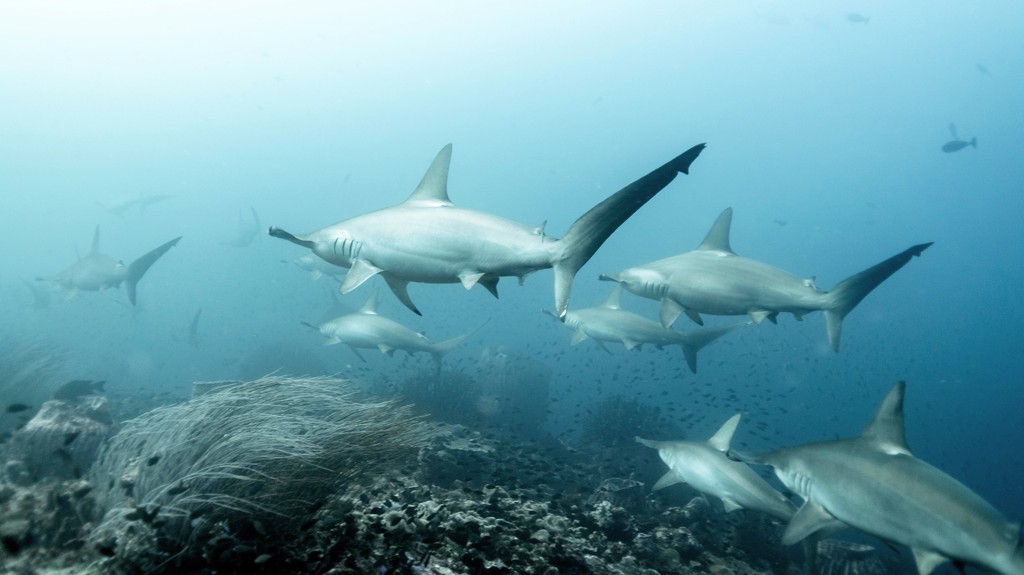
Spectacular Phinisi Sailing Ship
DEMA 2025 Deal
Take 5% off your trip
* Book by Dec 31, 2025